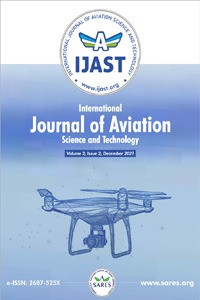Abstract
References
- Alpha (Navigation), Available at: https://en.wikipedia.org/wiki/Alpha_(navigation) (accessed 14 October 2020).
- Bhardwaj A., 2020, Terrestrial and Satellite-Based Positioning and Navigation Systems—A Review with a Regional and Global Perspective, Engineering Proceedings, 2, 41, 2-7.
- Blakey, J.H., 2006, Navigating Towards the Future: Transitioning from Terrestrial Radio Navigation to Satellite Navigation and Airborne Surveillance, IEEE Aerospace & Electronic Systems Magazine, May, 17-21.
- Chothani, A., Saindane, J., Mistari, H., Bhavsar, N., Shirsath, R., 2015, RFID-based location tracking system using a RSS and da, Proc. of the International Conference on Energy Systems and Applications (ICESA 2015), 30 October–1 November 2015, Pune, India, pp. 748–751.
- Erkal, Y. and Ç. Hacıyev, 2004, Determination of aircraft motion parameters using GNSS based on distance difference measurement and Doppler methods and error analysis, Aviation Advanced Technologies and Applications Symposium, Vol.1, December 9-10, 2004, Istanbul, Turkey.
- Gluch, M., Kirchner, J. Herzig, M., 2000, Development of Software Structure for Integrated Navigation Receivers in Shipping. IFAC Proc., 33, pp. 407–412.
- Groves, P.D.,2008, Principles of GNSS, Inertial, and Multisensor Integrated Navigation Systems. Boston; London: Artech House. Haciyev, Ç.M., 1999, Radyo Navigasyon (Radio Navigation), 1st edition, Istanbul Technical University, Istanbul.
- Hacıyev, Ç. and Ü. Üner, 1998, Guaranteed error analysis in determining the coordinates of aircraft by measuring distances, 2nd Aeronautical Symposium, May 11-15, 1998, Kayseri, Turkey.
- M. Kayton, & W. R. Fried (1997). Avionics navigation systems. John Wiley & Sons.
- Krinetskiy Ye.I. (ed.), 1979, Flight Tests of Rockets and Space Apparatus. Moscow: Maşinostroyeniye (in Russian).
- LORAN, Available at: https://en.wikipedia.org/wiki/LORAN, (available accessed 12 October 2020).
- McLean, D., 1990, Automatic Flight Control Systems. Hertfordshire, UK: Prentice Hall International.
- Omega (Navigation System). Available online: https://en.wikipedia.org/wiki/Omega_(navigation_system) (accessed on 14 October 2020).
- Sametoğlu, A.M. and Hajiyev, C., 2021, Investigation of the accuracy of terrestrial radio navigation methods for determining aircraft position, International Symposium on Aircraft Technology, MRO & Operations, June 28-30, 2021, Budapest, Hungary.
Abstract
The main objective of terrestrial radio navigation is position determination. In this study, the accuracy of the distance measurement, distance difference measurement, and integrated angle measurement/distance measurement terrestrial radio navigation methods is investigated. in order to calculate the position errors, simulations for the aircraft flight dynamics were carried out, and the obtained position values were compared with the actual values. The aircraft position determination methods were evaluated in the sense of accuracy. The position determination method with better accuracy was determined by comparing the absolute errors of the examined methods. Simulation and error analysis shows that the distance difference method is superior and gives more accurate position results. It was observed that the distance measurement method errors were smaller than the errors of the integrated angle measurement/distance measurement method.
Keywords
aircraft position determination distance measurement distance difference measurement line of positions terrestrial radio navigation.
References
- Alpha (Navigation), Available at: https://en.wikipedia.org/wiki/Alpha_(navigation) (accessed 14 October 2020).
- Bhardwaj A., 2020, Terrestrial and Satellite-Based Positioning and Navigation Systems—A Review with a Regional and Global Perspective, Engineering Proceedings, 2, 41, 2-7.
- Blakey, J.H., 2006, Navigating Towards the Future: Transitioning from Terrestrial Radio Navigation to Satellite Navigation and Airborne Surveillance, IEEE Aerospace & Electronic Systems Magazine, May, 17-21.
- Chothani, A., Saindane, J., Mistari, H., Bhavsar, N., Shirsath, R., 2015, RFID-based location tracking system using a RSS and da, Proc. of the International Conference on Energy Systems and Applications (ICESA 2015), 30 October–1 November 2015, Pune, India, pp. 748–751.
- Erkal, Y. and Ç. Hacıyev, 2004, Determination of aircraft motion parameters using GNSS based on distance difference measurement and Doppler methods and error analysis, Aviation Advanced Technologies and Applications Symposium, Vol.1, December 9-10, 2004, Istanbul, Turkey.
- Gluch, M., Kirchner, J. Herzig, M., 2000, Development of Software Structure for Integrated Navigation Receivers in Shipping. IFAC Proc., 33, pp. 407–412.
- Groves, P.D.,2008, Principles of GNSS, Inertial, and Multisensor Integrated Navigation Systems. Boston; London: Artech House. Haciyev, Ç.M., 1999, Radyo Navigasyon (Radio Navigation), 1st edition, Istanbul Technical University, Istanbul.
- Hacıyev, Ç. and Ü. Üner, 1998, Guaranteed error analysis in determining the coordinates of aircraft by measuring distances, 2nd Aeronautical Symposium, May 11-15, 1998, Kayseri, Turkey.
- M. Kayton, & W. R. Fried (1997). Avionics navigation systems. John Wiley & Sons.
- Krinetskiy Ye.I. (ed.), 1979, Flight Tests of Rockets and Space Apparatus. Moscow: Maşinostroyeniye (in Russian).
- LORAN, Available at: https://en.wikipedia.org/wiki/LORAN, (available accessed 12 October 2020).
- McLean, D., 1990, Automatic Flight Control Systems. Hertfordshire, UK: Prentice Hall International.
- Omega (Navigation System). Available online: https://en.wikipedia.org/wiki/Omega_(navigation_system) (accessed on 14 October 2020).
- Sametoğlu, A.M. and Hajiyev, C., 2021, Investigation of the accuracy of terrestrial radio navigation methods for determining aircraft position, International Symposium on Aircraft Technology, MRO & Operations, June 28-30, 2021, Budapest, Hungary.
Details
| Primary Language | English |
|---|---|
| Subjects | Aerospace Engineering |
| Journal Section | Research Articles |
| Authors | |
| Publication Date | December 24, 2021 |
| Submission Date | August 9, 2021 |
| Published in Issue | Year 2021 Volume: 02 Issue: 02 |
Please find the article preperation and structure guides in author guidelines section.
Please do not hasitate to contact with us in here.


